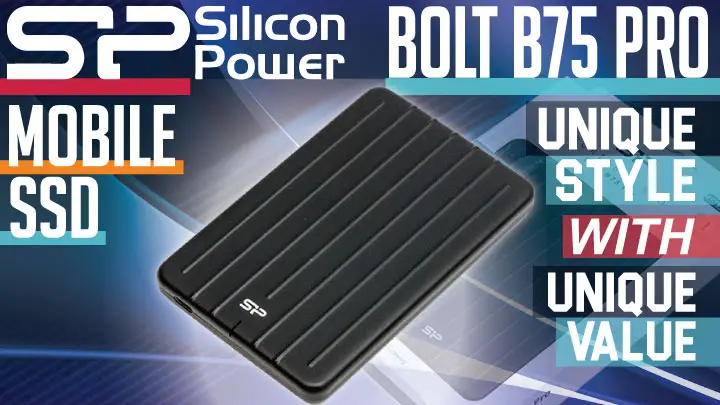![]()
The shipping container is classic Silicon Power. That is to say it ticks all the right boxes but may be a touch monochromatic for some people’s tastes. We personally are ambivalent, as the large window in the front that shows the entirety of the Bolt B75 Pro more than makes up for the ‘lack’ of attention getting colors. Internally the shipping container is using a plastic tray type affair to keep the Bolt B75 Pro safe from harm. Given the fact that the Bolt B75 Pro is military drop rated to 122cm… securing it and keeping it from sliding around while in transit is more than ‘good enough’.
![]()
The included accessories are top notch – and belie the low asking price of this new value orientated series. In grand total you will find the typical warranty and information pamphlet, and two USB cables. A Type-C to Type-C and a Type-C to Type-A. This is pretty common list of accessories for good external storage solutions these days, but what is uncommon is the fact that both of these USB 3.1 gen 2 cables are covered in a nice and tight braid. Put simply, these are premium looking cables that would be right at home in a LaCie or Apple branded product. The fact Silicon Power was able to include some of the best USB 3.1 gen 2 cables we have seen from any manufacture and come in with such a relatively low asking price is impressive.
![]()
The exterior of the Bolt B75 Pro is made from a lightweight alloy or aluminum (we were not going to chip off a piece, and burn it to confirm one way or the other). Either way it does not matter. It is going to take a beating before failure. Quite honestly, we would be more concerned with dents than we would be with cracking. So yes, this is a robust and durable exterior chassis to say the least. It however is not perfect.
![]()
There are two issues that buyers should be aware of. One important, one not so much. The important issue is the paint is not precisely durable. Silicon Power states on the box it is ‘scratch resistant’ but a fingernail can remove it. Thus, it is not quite as durable as you would be led to believe by the shipping container information. With hard use it is going to turn into first a ‘gray’ color and then a ‘silver’ one as the paint wears away and the underlying bare alloy is exposed. In between these stages it is going to look a touch rough (which may be a point in its favor if you are into that look).
Obviously during the ‘baking’ or curing process the paint did not properly adhere to the underlying metal in our sample. On a sample size of one it is hard to tell if this is an actual issue with all B75 Pro’s or simply poor quality control. In other words, barring more information Caveat Emptor is in full effect when it comes to the ‘scratch resistance’ of the Bolt B75 Pro. To be clear. This will in no shape nor form impact the lifespan of the Bolt B75 Pro. This is simply an aesthetics issue.
![]()
Moving on. The other is the overall aesthetics of the Bolt B75 Pro are rather unusual. Silicon Power states that their designers were inspired by Junker F series planes. These planes were indeed revolutionary and ground breaking for their day – just like the Bolt B75 Pro. However, they were distinctive in that they used ‘corrugated’ copper/aluminum alloy (aka ‘duralumin’) for the skin of their planes. Sadly, if you do not know the rather cool back story on the Bolt B75 Pro… you would be more tempted to liken it to that of a Quonset hut. Either way the ridges will keep air flowing around all sides of the case so it may look odd (but make for a good conversation starter), but it does have a good reason for being this way beyond aesthetics.
Shucking this drive is actually very, very easy. Silicon Power has used four screws (one per corner) to secure one half of the chassis to the other half. Beyond being easy to open this is a much… much more secure way of doing things than relying on press fit clips. In either case, the interior configuration is rather unusual.
![]()
What we mean by this is in typical USB devices the ‘solid state drive’ PCB and its SATA to USB bridge board are bare and attached directly to the USB exterior enclosure. Silicon Power on the other hand has taken their A55 2.5-inch SATA solid state drive series, removed the labels and attached an adapter card directly to the SATA power and data ports. Then using a plastic internal suspension setup used this as their foundation for the Bolt B75 Pro.
![]()
The upside is that at worst the ASMedia ASM234cm based adapter card is going to break but your data will be safe and sound – as the exterior of the drive will be crushed long before any stress is placed on the 2.5-inch SATA drive inside.
![]()
The downside is the A55 series is a touch long in the tooth. It uses a SMI SM2258XT controller, which is ‘DRAM-less’ and as such has zero onboard RAM to act as a cache buffer. More concerning is the fact that when paired with uber high-density 3D TLC NAD there is a lot less NAND layers per channel of the controller. In this instance the A55 comes with two 512GB IMFT 3D TLC NAND ICs. For most external storage needs the lack of small file performance will not be noticeable… but it does put the Bolt B75 Pro at a distinct disadvantage compared to more well-known brand’s offerings most of which use newer and faster components. Of course, the loss in performance is probably going to be more than made up for in lower asking price. Only you can decide if this is the case or not, but in the following pages it should be clear what trade-offs your will be making and if it is indeed worth making them.











